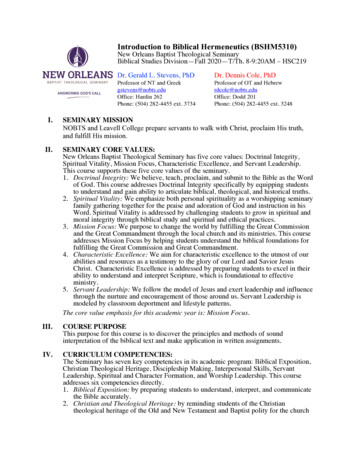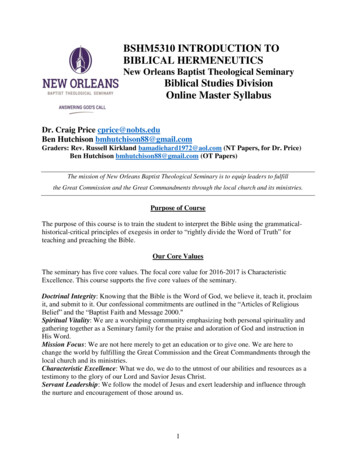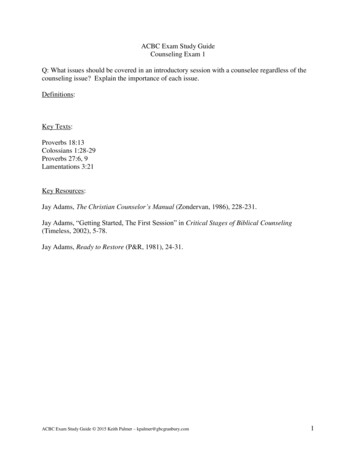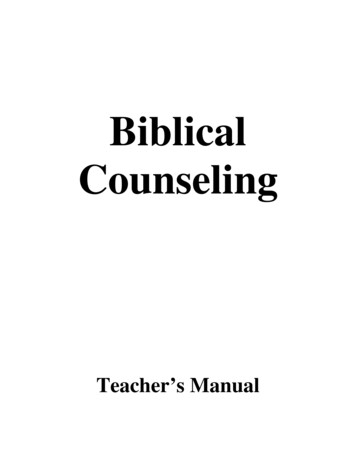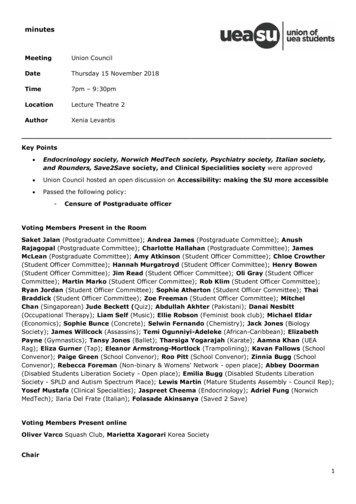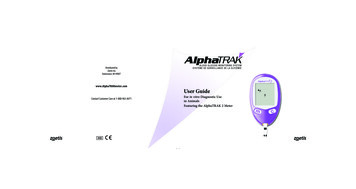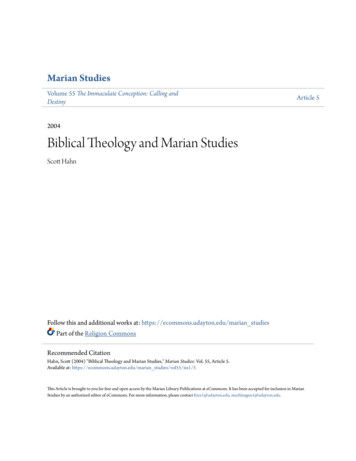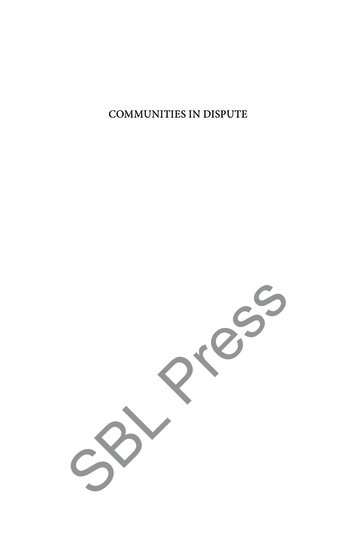
Transcription
SBLPressCommunities in Dispute
Early Christianity and Its LiteratureGail R. O’Day, General EditorSBLPressEditorial Board:Warren CarterBeverly Roberts GaventaDavid HorrellJudith M. LieuMargaret Y. MacDonaldNumber 13
Communities in DisputeCurrent Scholarship on theJohannine EpistlesEdited bySBLPressR. Alan Culpepper and Paul N. AndersonSBL PressAtlanta
Copyright 2014 by SBL PressAll rights reserved. No part of this work may be reproduced or transmitted in any formor by any means, electronic or mechanical, including photocopying and recording, or bymeans of any information storage or retrieval system, except as may be expressly permitted by the 1976 Copyright Act or in writing from the publisher. Requests for permissionshould be addressed in writing to the Rights and Permissions Office, SBL Press, 825 Houston Mill Road, Atlanta, GA 30329 USA.Library of Congress Cataloging-in-Publication DataLPressCommunities in dispute : current scholarship on the Johannine epistles / edited by R.Alan Culpepper and Paul N. Anderson.p. cm. — (Society of Biblical Literature Early Christianity and its literature ;number 13)Includes bibliographical references and index.ISBN 978-1-62837-015-7 (paper binding : alk. paper) — ISBN 978-1-62837-016-4(electronic format) — ISBN 978-1-62837-017-1 (hardcover binding : alk. paper)1. Bible. Epistles of John—Criticism, interpretation, etc. I. Culpepper, R. Alan. II.Anderson, Paul N., 1956–.BS2805.52.C66 2014227'.9406—dc232014039766SBPrinted on acid-free, recycled paper conforming toANSI/NISO Z39.48-1992 (R1997) and ISO 9706:1994standards for paper permanence.
ContentsAbbreviations.viiIntroductionR. Alan Culpepper and Paul N. Anderson.1Setting the Stage: The Context for the ConversationR. Alan Culpepper .3Part 1: The Relationship between the Gospel and the EpistlessRaymond Brown’s View of the Crisis of 1 John: In the Light ofSome Peculiar Features of the Johannine GospelUrban C. von Wahlde.19esThe Community that Raymond Brown Left Behind: Reflectionson the Johannine Dialectical SituationPaul N. Anderson.47PrThe Relationship between the Gospel of John and 1 JohnR. Alan Culpepper.95Part 2: The Church in the Johannine EpistlesSBLThe Audience of the Johannine EpistlesJudith M. Lieu.123The Missional Role of ὁ ΠρεσβύτεροςPeter Rhea Jones.141
vicontentsPart 3: The Theology and Ethics of the EpistlesThe Cosmic Trial Motif in John’s LettersAndreas J. Köstenberger.157Spirit-Inspired Theology and Ecclesial Correction: ChartingOne Shift in the Development of Johannine Ecclesiologyand PneumatologyGary M. Burge.179The Antichrist Theme in the Johannine Epistles and Its Rolein Christian TraditionCraig R. Koester.187On Ethics in 1 JohnJan G. van der Watt.197The Significance of 2:15–17 for Understanding the Ethics of1 JohnWilliam R. G. Loader.223essCompleted Love: 1 John 4:11–18 and the Mission of the NewTestament ChurchDavid Rensberger.237ResponsePrMoving the Conversation Forward: Open Questions andNew DirectionsPaul N. Anderson.275SBLWorks Cited.289Contributors.313Ancient Sources Index.315Name Index.329
AbbreviationsSBLPress4 Regn.Dio Chrysostom, De regno iv (Or. 4)AB Anchor BibleAbr.Philo, De AbrahamoABRL Anchor Bible Reference LibraryACNT Augsburg Commentaries on the New TestamentAcTSup Acta Theologica SupplementumAgr.Philo, De agriculturaAJEC Ancient Judaism and Early ChristianityAlex.Ad Alexandrinos (Or. 32)Amic.Cicero, De amicitiaAMP Amplified BibleAnBib Analecta BiblicaAndr.Euripides, AndromacheANFAnte-Nicene FathersAnt.Josephus, Jewish AntiquitiesANTC Abingdon New Testament CommentariesASV American Standard VersionBBEBible in Basic EnglishBDAGBauer, Walter, Frederick W. Danker, William F. Arndt,and F. Wilbur Gingrich. Greek-English Lexicon of the NewTestament and Other Early Christian Literature. 3rd ed.Chicago: University of Chicago Press, 1999.BDFBlass, Friedrich, Albert Debrunner, and Robert W. Funk.A Greek Grammar of the New Testament and Other EarlyChristian Literature. Chicago: University of ChicagoPress, 1961.BECNTBaker Exegetical Commentary on the New TestamentBETLBibliotheca ephemeridum theologicarum lovaniensiumBeiträge zur historischen TheologieBHTBibLebBibel und Leben-vii-
viiiabbreviationsBiblical Interpretation SeriesBulletin of the John Rylands University Library of ManchesterBKBibel und KircheBLBibel und LiturgieBRBiblical ResearchBTBBiblical Theology BulletinBWA(N)TBeiträge zur Wissenschaft vom Alten (und Neuen) TestamentBZBiblische ZeitschriftBZNWBeihefte zur Zeitschrift für die neutestamentliche WissenschaftCBQCatholic Biblical QuarterlyCCSLChristianorum: Series latinaCEBContemporary English BibleCEVContemporary English VersionCher.Philo, De cherubimContempl.Philo, De vita contemplativaPhilo, De decalogoDecal.DeusPhilo, Quod Deus sit immutabilisDiatr.Epictetus, DiatribaiDid.DidacheDivThomDivus ThomasECC Eerdmans Critical CommentaryExegetical Dictionary of the New Testament. Edited byEDNTHorst Balz and Gerhard Schneider. Grand Rapids: Eerdmans, 1990–1993.EKKNT Evangelish-katholischer Kommentar zum Neuen TestamentIgnatius, To the EphesiansEph.Epigr.Martial, Epigrammaton libriPliny the Younger, Epistulae ad TrajanumEp. Tra.ERV English Revised VersionESV English Standard VersionEth. eud.Aristotle, Ethica eudemiaEth. nic.Aristotle, Ethica nichomacheaExpTimExpository TimesFlacc.Philo, In FlaccumFaith and MissionFMSBLPressBISBJRL
ixAbbreviationsfragmentPhilo, De fuga et inventioneGood News TranslationIrenaeus, Adversus haeresesHorizons in Biblical TheologyShepherd of Hermas, MandateThucydides, History of the Peloponnesian WarHistoria ecclesiasticaHandbuch zum Neuen TestamentHarper’s New Testament CommentariesHerders theologischer Kommentar zum Neuen TestamentHUTHermeneutische Untersuchungen zur TheologieHyp. Arch. Nag Hammadi Codices II 4, Hypostasis of the ArchonsIBC Interpretation: A Bible Commentary for Teaching andPreachingICC International Critical CommentaryIntInterpretationJBLJournal of Biblical LiteratureJSJSupJournal for the Study of Judaism Supplement SeriesJSNTJournal for the Study of the New TestamentJSNTSupJournal for the Study of the New Testament: SupplementSeriesJSPSupJournal for the Study of the Pseudepigrapha: SupplementSeriesJTSJournal of Theological StudiesKEKKritisch-exegetischer Kommentar über das Neue Testament (Meyer-Kommentar)King James VersionKJVLBThe Living BibleLeg.Plato, LegesPhilo, Legatio ad GaiumLegat.Library of New Testament StudiesLNTSPlato, LysisLys.Magn.Ignatius, To the MagnesiansMart. Pol.Martyrdom of PolycarpMNTC Moffatt New Testament CommentaryMet. Apuleius, MetamorphosisSBLPressfrg.Fug.GNTHaer.HBTHerm. Mand.Hist.Hist. eccl.HNTHNTCHTKNT
xabbreviationsSBLPressMetaph.Aristotle, MetaphysicaMor. Plutarch, MoraliaMos.Philo, De vita MosisNAB New American BibleNAC New American CommentaryNASB New American Standard BibleNCB New Century BibleNCV New Century VersionNEB New English BibleNET New English TranslationNIBNew Interpreter’s Dictionary of the BibleNIBCNT New International Biblical Commentary on the New TestamentNICNT New International Commentary on the New TestamentNIGTC New International Greek Testament CommentaryNIV New International VersionNJB New Jerusalem BibleNJKV New King James VersionNLT New Living TranslationNovTSup Novum Testamentum SupplementsNRSV New Revised Standard VersionNTDDas Neue Testament DeutschNTL New Testament LibraryNTSNew Testament StudiesOpif.Philo, De opificio mundiEuripides, OrestesOrest.ÖTKÖkumenischer Taschenbuch-KommentarPhaedr.Plato, PhaedrusPolycarp, To the PhilippiansPhilPhld.Ignatius, To the PhiladelphiansPol.Aristotle, PoliticaPhilo, De posteritate CainiPost.PresbyterionPresbPRStPerspectives in Religious StudiesQGPhilo, Quaestiones et solutiones in GenesinREBRevised English BibleRes.Tertullian, Resurrection of the FleshResp.Plato, RespublicaReview and ExpositorRevExp
xiAbbreviationsSBLPressRBLReview of Biblical LiteratureRNTRegensburger Neues TestamentRSVRevised Standard VersionSacr.Philo, De sacrificiis Abelis et CainiSBLDS Society of Biblical Literature Dissertation SeriesSBLECL Society of Biblical Literature Early Christianity and ItsLiteratureSBLSymS Society of Biblical Literature Symposium SeriesSemeiaSt Semeia StudiesSHBC Smyth & Helwys Bible CommentarySJOTScandinavian Journal of the Old TestamentSmyrn.Ignatius, To the SmyrnaeansSNTSMS Society for New Testament Studies Monograph SeriesSNTW Studies of the New Testament and Its WorldSomn.Philo, De somniisSP Sacra PaginaSpec.Philo, De specialibus legibusSRStudies in ReligionTBTThe Bible TodayTEV Today’s English VersionTHKNTTheologischer Handkommentar zum Neuen TestamentTLZTheologische LiteraturzeitungToday’s New International VersionTNIVTNTC Tyndale New Testament CommentariesIn epistulam Johannis ad Parthos tractatusTract. ep. Jo.Ignatius, To the TralliansTrall.TRuTheologische RundschauTTSTheologische Texte und StudienTUGAL Texte und Untersuchungen zur Geschichte der altchristlichen LiteraturTZTheologische ZeitschriftUBS United Bible SocietiesCyprian, De catholicae ecclesiae unitateUnit. eccl.Vir. Illus.Cornelius Nepos, De Viris IllustribusVirt.Philo, De virtutibusVit.Diogenes Laertius, Lives of Eminent PhilosophersWBCWord Biblical CommentaryWUNTWissenschaftliche Untersuchungen zum Neuen Testament
xiiWord and WorldZürcher BibelkommentarZeitschrift für Neues TestamentZeitschrift für Theologie und KircheSBLPressWWZBKZNTZTKabbreviations
IntroductionR. Alan Culpepper and Paul N. AndersonSBLPressThe Epistles of John involve only seven chapters of the New Testament,but they offer one of the most interesting windows into the life of the earlychurch available, with extensive implications for understanding (and misunderstanding) a host of interpretive issues. First John does not identify itsaudience, and the author does not introduce himself. The author of 2 Johnand 3 John refers to himself as “the Elder” (ὁ πρεσβύτερος in Greek). Wereall three texts written by the same author? If so, then why the differencesin the author’s self-identification? And the audiences of 2 and 3 John arespecified as “the elect lady and her children” (2 John 1) and “the belovedGaius” (3 John 1). Why the differences in declared audiences? Further,there is a considerable difference in length between the letters: the fivechapters of 1 John are five times as long as 2 and 3 John combined. Howare these facts to be understood and thus interpreted?Another set of issues emerges also at the start: the relation of theJohannine Epistles to the Johannine Gospel and Apocalypse. While Revelation is the most distinctive among the five Johannine writings (and theonly one to assert the name of its author, indirectly and directly: “John,”Rev 1:1, 4, 9; 22:8), its style and form are considerably different from theother Johannine writings. That is why most scholars feel it is safer to leaveit out of discussions related to the Gospel and Epistles of John, despite anumber of Johannine similarities. The relation of the Gospel to the Epistles of John, however, cannot be ignored, and questions range from whichwas earlier and later, whether they represent a similar setting, whethertheir authorship was common, and whether purposes were similar ordifferent. It could even be that a multiplicity of authorial and editorialhands were involved in the production of the Johannine corpus, and sucha likelihood is bolstered by the inclusion of first-person plural language(“we,” “us,” and “our”—in the Gospel and the Epistles), raising doubts that-1-
2Communities in Dispute: the Johannine EpistlesSBLPressa single individual was responsible for all of these writings or that theywere written to the same situation.As a result, understanding the content of the Johannine Epistles hingesdirectly upon solid inferences of the contexts in which they were written,the concerns of their authors and editors, the relations of these writingsto other contemporary literature (especially the Johannine), and the literary features of each composition. As Raymond Brown has made us aware,while the Johannine “eagle,” representing the elevated perspective of theFourth Gospel, soars above the ground it surveys, the Johannine Epistlesbetray eaglets fighting over their place in the nest, with schisms, rejections,embraces, and invective language—all showing a far less tidy portraitureof early Christianity than more romanticized views have allowed.If the Johannine leadership and its adversaries reflect communities indispute, however, what about Johannine scholarship over the last severaldecades? Indeed, as this collection of incisive essays by leading Johanninescholars shows, some points of convergence are evident, but top scholars also take issue with each other as to how this material came together,what was going on within the Johannine situation, and what its contentimplies for both theological and ethical interpretations of the New Testament. Therefore, today’s “Johannine School”—the international community of Johannine scholars today—also finds itself in dispute about important issues, not simply tangential ones, and this collection of essays throwssome of those similarities and differences into sharp relief.These papers were invited and delivered at the Symposium on theJohannine Epistles at the McAfee School of Theology at Mercer Universityin Atlanta, Georgia, November 17–19, 2010, and they are gathered intothree sections within the present volume. Part 1 deals with “The Relationship between the Gospel and the Epistles”; Part 2 addresses “The Churchin the Johannine Epistles”; Part 3 concludes, then, with “The Theology andEthics of the Epistles.” Alan Culpepper introduces the volume by settingthe stage for the conversation, providing terse summaries of the papers’contributions, and Paul Anderson introduces each section by outliningsome of the key issues in each part and concludes with an overview of thecollection—moving the discussion forward regarding emerging aspects ofconsensus as well as continuing, open questions.So, regarding state-of-the-art discussions of earlier communities in dispute and the texts by which they are illumined let the conversation begin!
TBT The Bible Today teV today’s english Version tHKnt Theologischer Handkommentar zum neuen testament TLZ Theologische Literaturzeitung tniV today’s new international Version tntC tyndale
